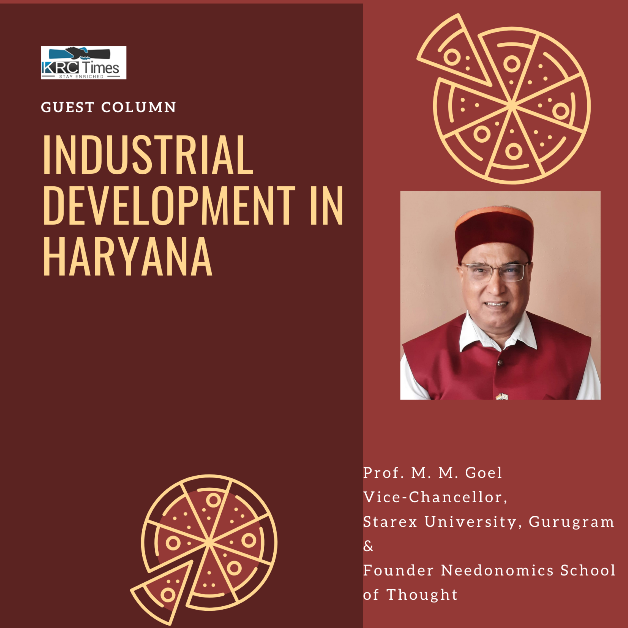It has to be noted that State income has increased manifold due to these efforts of the Government
 Dr. M. M. Goel
Dr. M. M. Goel

Haryana is one of the leading states in terms of industrial production offering a wide range of fiscal and policy incentives for boosting the growth of various sectors in the economy. Haryana has transformed and emerged as a veritable hub of knowledge and a vibrant and fast-growing industrial powerhouse. Haryana is strategically located in the heart of India and surrounds the National Capital Delhi on three sides. It is worth mentioning that about 40 percent of the State falls in the National Capital Region (NCR) and 66 percent under the Delhi-Mumbai Industrial Corridor (DMIC) Influence zone. The State has made impressive strides over the years to make a special place for itself in the fields of automobiles, electronic hardware, engineering, hi-technology industries, Information Technology, leather, and textiles. The State has been a leader in the manufacturing of a number of products like cars, footwear, scientific instruments, tractors, two-wheelers, etc. It is pertinent to mention that Gurugram has emerged as the Business Process Management (BPM) Capital of the country besides being home to offices of a number of international & national corporate.
It has to be noted that State income has increased manifold due to these efforts of the Government. As per the advance estimates for 2021-22, Haryana’s GSDP at current prices has been estimated at Rs. 8,87,252 crore (US $ 121.77 billion), an increase of 7% YoY. At current prices, Haryana’s GDP growth is projected at 15.8% for FY22. Merchandise exports from Haryana reached US$ 12.06 billion in FY20 and US$ 11.60 billion in FY21. Haryana is one of the preferred destinations for auto majors and auto-component manufacturers. The state produces 2/3rd of passenger cars, 50% of tractors, 60% of motorcycles, and 50% of the refrigerators manufactured in the country. Automobiles and auto component exports from Haryana were ~US$ 1.070.3 million in FY20 and reached US$ 618.7 million in FY21. Haryana is among the leading states also in terms of IT export. Export of electric machinery and equipment for Haryana reached US$ 379.3 million in FY20 and US$ 325.36 million in FY21.
Many Governments came and gone and they have accordingly to improve the overall functioning of the Haryana economy in general and Industrial development in particular. Considering the importance of improving the business ecosystem in the state, critical minimum efforts (in form of measures) have been made by the Government. This has taken Haryana from the sixth position to the third position in the Ease of Doing Business Ranking- 2017 conducted by the Central Department of Industrial Policy and Promotion. But Haryana’s law requiring private companies to reserve jobs for local residents is unlikely to impact the state’s Ease of Doing Business ranking and Haryana’s rank plummeted to 16 in 2019 from No. 3 in 2018.
The Government of Haryana has taken series of proactive steps such as simplifying processes, reducing government interface, policy changes, and building sector-focused capabilities to make Haryana an ideal investment hub. In this regard, The Industries Department launched a path-breaking ‘Enterprise Promotion Policy- 2015’ (EPP) to propel the state to the next level of growth trajectory. To boost the sectors in focus, sector-specific policies have been introduced by the Government. Policies pertaining to IT, IT-enabled services and ESDM, start-ups, agro-business, and food processing have already been launched with a focus on key fiscal incentives, and balanced regional development. To ease the process of approvals, the Government has integrated industry-related services with the HEPC- Single Roof Mechanism which ensured the clearances are granted in 45 days. More than 90 percent of the industries in the Haryana State fall under the domain of MSME. The Government accords high priority to the development of MSMEs, as they have a critical role in the economic growth of the state. The Enterprise Promotion Policy 2015 focuses primarily on incentives and the development of the MSME sector. The recent “Haryana MSME Policy- 2018” also aims at strengthening the entire MSME ecosystem, covering infrastructure, markets, finance, and technology.
The vision of the Aerospace & Defence Policy 2016 of the Haryana Government is to develop Haryana as the country’s prominent aerospace & defense manufacturing hub and preferred MRO, FBO destination of the Asian region. Haryana is moving towards positioning itself as the country’s leading Aerospace & Defence Manufacturing hub. The State has well-recognized manufacturing proficiency and state-of-the-art infrastructure that can help in meeting India’s critical need to be self-reliant in the sector.
To make the slogan ‘Minimum Government and Maximum Governance’ a great success, Samadhan Diwas, an initiative bringing governance on doorsteps, apprises investors about various regulatory reforms, single-window clearance system, policies, key incentives, etc. and also addresses issues of industrialists. The industrialists have raised 171 issues and of these 57 have already been addressed and 85 are being addressed by the Haryana Government.
Foreign Direct Investment (FDI) also plays a significant role in the growth of any economy including Haryana. To attract more and more foreign investments and to make Haryana the top investment destinations in the country, Haryana Government is committed to providing infrastructure facilities in the State. Due to this, more than 20 international companies such as Can-Pack, Minda Kosei, Panasonic, Motherson, Hyundai Motors, etc. have invested in the state, which will generate employment opportunities in the State. To boost the investment momentum in the state, Haryana has organized its first Global Investors’ Summit ‘Happening Haryana’ in 2016 with the objective to present Haryana as the most preferred investment destination. ‘Happening Haryana’ summit received an overwhelming response from the investors in which 160 international delegates from 12 countries participated. About 359 MoUs of the proposed investment of Rs 5.87 lakh crore were signed at the summit. Haryana Government also organized “Pravasi Haryana Diwas” where Parvasi Haryanvi from across the world was invited with an aim to offer an opportunity to them to invest in the state. Twenty-four MoUs with Rs 20,000 crore of potential investment were signed. With these global outreach programs,
The food processing industry plays an important role in the development of any economy including Haryana through the integration and synergy it provides between agriculture and industry, the two pillars of economic prosperity. The growth of the food processing sector is essential to meet the twin objective of “inclusive growth” and “food security”. The government of Haryana Agri-Business and Food Processing Policy 2018 endeavors to give the required impetus to the Food processing industry in the state. Further by establishing efficient forward and backward linkages, it aims to create greater employment opportunities across the entire food value chain, thus promoting agriculture and rural prosperity. Food processing is the bridge between the industry and farming and the policy aims at doubling the farmer’s income through the large-scale promotion of fresh produce of Haryana especially fruits, vegetables, milk, and fish.
Besides these efforts, industrial growth has been hit as industries are continuously migrating from Haryana due to many reasons. As a result, Haryana is consistently facing a high unemployment rate in India. The June report released by CMIE has also confirmed that Haryana is once again on the top with an unemployment rate of 27.9 percent. The report reveals that the unemployment rate of Haryana is almost three times higher than the national average which is a serious matter of concern. State Government is doing efforts in this regard which are necessary but not sufficient. To make them sufficient, much more focus on industrial development is required for the overall economic growth of Haryana State.
In nut-shell, Haryana is one of the fastest-growing states as a favorable destination for stable and profitable investments since the last decade due to the competitive advantages provided by the State Government. The state has proven long-term sustainability and growth potential in many growth-promising sectors. Most importantly, the Government of Haryana has been taking proactive measures to revive the economy in the post COVID scenario to support the promising industries, encourage MSMEs, and taking all possible actions to attract foreign investments. These initiatives of the Government would go a long way to settle the short-lived glitches caused by COVID-19 led lockdown and supply chain disruptions.
However, there is always a scope of improvement with faithfulness using the wisdom of the professionals for the economy in the execution of the ongoing schemes and programmers for the industrial development of Haryana. For becoming job givers instead of job seekers, we have to adopt entrepreneurship in the tourism sector capable of doing wonders with the highest employment multiplier. Entrepreneurship of all kinds calls for an action-oriented and highly motivated individual who is ready to achieve goals. To be motivated for self-employment, we have to adopt entrepreneurship in services more than manufacturing with ample opportunities including empowerment of consumers with a competitive advantage, convenience, fewer hassles, quick adjustment to market conditions, and low-cost cloud shops. To create entrepreneurship, we need to convert Khadhi and Village Industries Commission (KVIC) into MNC which can give brand-name to the products under MSME for marketing online and offline. We have to be aware, alert, and awake for the challenges in entrepreneurship and remain enthusiastic with all precautions including GST and cyber laws. All of us have to play the role of street smart (simple, moral, action-oriented, responsive, and transparent) consumers, producers, distributors, and traders in the national interest. Entrepreneurship can be people-friendly and socially beneficial only if undertaken in accordance with the NAW (Need, Affordability, and Worth) approach for marketing goods and services which falls in the domain of Needonomics as Need-entrepreneurship.
(Prof. M. M. Goel is the Vice-Chancellor of Starex University, Gurugram & Founder Needonomics School )
Advertisement | KRC Foundation

Message to get a callback and schedule an online meeting.
WP: +91-9330830083

